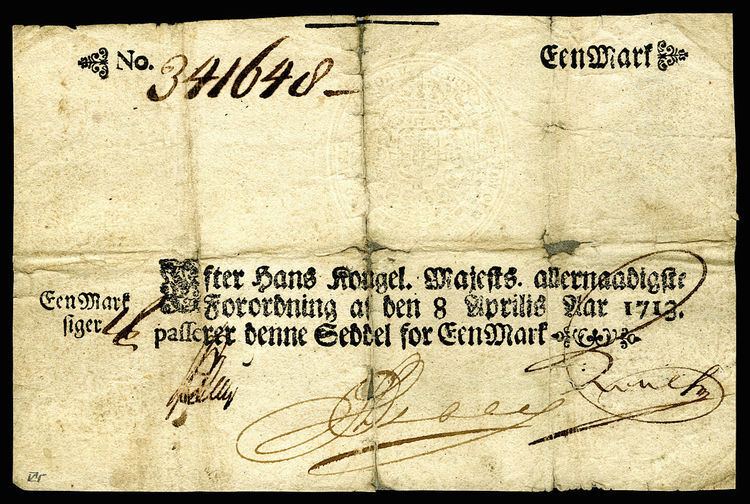 | ||
The rigsdaler was the name of several currencies used in Denmark until 1875. The similarly named Reichsthaler, riksdaler and rijksdaalder were used in Germany and Austria-Hungary, Sweden and the Netherlands, respectively. These currencies were often anglicized as rix-dollar or rixdollar.
Contents
History
The Danish currency system established in 1625 consisted of 12 penning = 1 skilling, 16 skilling = 1 mark, 6 mark = 1 rigsdaler and 8 mark = 1 krone.[1] From 1713, two separate systems coexisted, courant and species, with courant being a debased currency also used for banknote issue. The rigsdaler species contained 4⁄37 of a Cologne mark of fine silver (i.e., 9 1⁄4 rigsdaler species equalled one Cologne mark).
In 1813, following a financial crisis, a new currency system was introduced, based on the rigsbankdaler. For six rigsdaler in old banknotes, a new one rigsbankdaler note was exchanged. The rigsbankdaler This was divided into 96 rigsbank skilling and was equal to half a rigsdaler species or 6 rigsdaler courant.
A further change was made in 1854. The rigsdaler species name disappeared and the names rigsbankdaler and rigsbank skilling became rigsdaler and skilling rigsmønt. Thus, there were 96 skilling rigsmønt to the rigsdaler.
In 1873, Denmark and Sweden formed the Scandinavian Monetary Union and the rigsdaler was replaced by the Danish krone on 1 January 1875. An equal valued krone/krona of the monetary union replaced the three currencies at the rate of 1 krone/krona = 1⁄2 Danish rigsdaler = 1⁄4 Norwegian speciedaler = 1 Swedish riksdaler. Because of this reform, where two Danish kroner was then of equal worth to the Danish daler, the "tokrone" coins got the common name of "daler" as they were functionally the same (the real daler got retired). This has however, become an increasingly uncommon name as a result of a gap in the "tokrone" coin's existence from 1959 to 1993.
Coins
In the late 18th century, coins were issued in denominations of 1⁄2, 1, 2, 4, 8, 24 and 32 skilling, 1⁄15, 1⁄4, 1⁄3, 1⁄2 and 1 rigsdaler specie.
Between 1813 and 1815, copper coins bearing the legend "rigsbanktegn" ("rigsbank token") were issued in denominations of 2, 3, 4, 6, 12 and 16 skilling. From 1818, 1, 2 and 32 rigsbank skilling coins were issued, with 1 rigsdaler species from 1820. From 1826, gold coins were issued denominated in "Frederiks d'Or" or "Christians d'Or" (depending on the name of the ruling king). The "d'or" was nominally worth 10 rigsdaler, although the currency was on a silver standard. In 1838, 1⁄2 rigsbank skilling coins were introduced.
Between 1840 and 1843, a new coinage was introduced, consisting of 1⁄5, 1⁄2, 1, 2, 3, 4, 8, 16 and 32 rigsbank skilling, 1 rigsbankdaler and 1 rigsdaler species. Denominations between 4 rigsbank skilling and 1 rigsbankdaler were also inscribed with the denomination in the currency of Schleswig-Holstein, the Schilling Courant, of which there were 60 to the Speciethaler, equal to the rigsdaler species. These denominations were 1 1⁄4, 2 1⁄2, 5, 10 and 30 Schilling Courant.
The renaming of the currency units in 1854 lead to the issuing of coins for 1⁄2, 1, 4 and 16 skilling rigsmønt, 1 and 2 rigsdaler. Gold "d'or" coins continued to be issued (see above).
